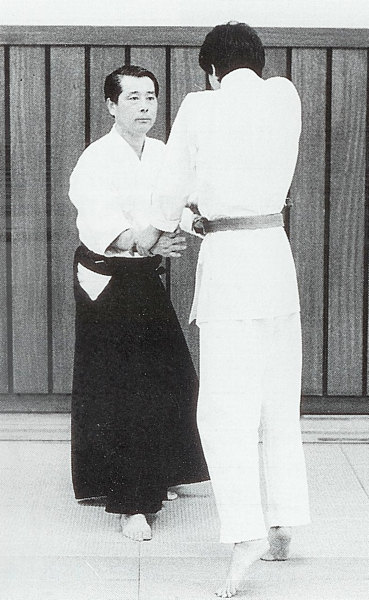
Keisetsu Yoshimaru demonstrating Aiki-age
“Aikido no Ogi”, by Keisetsu Yoshimaru
Keisetsu Yoshimaru (吉丸慶雪) trained under Yukiyoshi Sagawa from 1961 to 1976.
Yukiyoshi Sagawa began training in Daito-ryu with his father, a student and Kyoju Dairi (licenced “Assistant Instructor” – the same license that Aikido Founder Morihei Ueshiba received) of Sokaku Takeda. Sokaku Takeda actually lived with the Sagawa family for some time, and Sagawa started training with him around 1914, about a year before Morihei Ueshiba met Takeda at the Hisada Inn in Hokkaido and became his student. He was once considered to be the successor to Sokaku Takeda.
Interestingly, there was once an agreement for Sagawa to become an instructor at the Aikikai Hombu Dojo around 1956, but he took exception to some remarks about Sokaku Takeda made by Morihei Ueshiba in an interview with the Yomiuri Shimbun around that time and changed his mind.
After Yoshimaru left Sagawa Dojo he also trained under Kinbei Sato (佐藤金兵衛), who had trained in Daito-ryu under Kakuyoshi Yamamoto (山本角義), another direct student of Sokaku Takeda.
Although Keisetsu Yoshimaru remains a somewhat controversial figure in Daito-ryu, he has published a number of interesting books with quotes from Yukiyoshi Sagawa, most of which have never been translated into English before.
This is the second part of a two part translation of the “Bujutsu and Ki-Ryoku” chapter of “Aikido no Ogi” (合氣道の奥義 / “The Secrets of Aikido”), which consists mainly of quotes from Yukiyoshi Sagawa, many of which recount Sagawa’s memories of Sokaku Takeda. You may wish to start with part 1 before you read this section.
You may also wish to read another two part translation from “Aikido no Ogi” which contains quotes from Yukiyoshi Sagawa relevant to building the “Aiki no Rentai” (合気之錬体 / “The Conditioned Body of Aiki”): Part 1 | Part 2
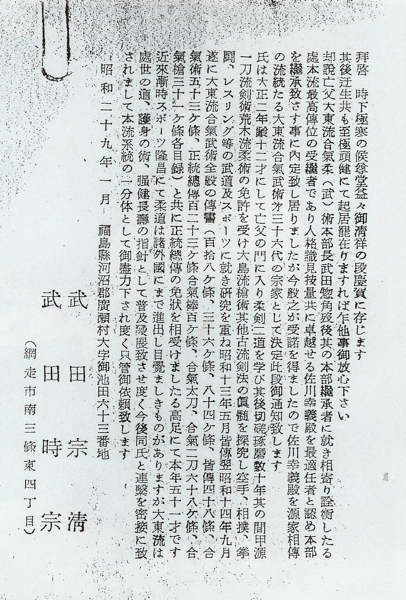
Postcard from Tokimune Takeda and his brother Munekiyo
appointing Yukiyoshi Sagawa the 36th Soke of
Daito-ryu Aiki-bujutsu – January 1954
Sagawa stepped aside on January 25th 1956
and took the title “Sohan” (宗範)
from “Transparent Power” by Tatsuo Kimura (透明な力・木村達雄)
Bujutsu (武術) and Ki-Ryoku (気力), Part 2
The Oral Transmission of Yukiyoshi Sagawa Sensei
(from “Aikido no Ogi” by Keisetsu Yoshimaru, translation by Christopher Li)
Translator’s Note: “Ki-Ryoku” (気力) is “Ki Power”, and in most of the cases here Sagawa is using it in the sense of “force of will”. He also makes use of the phrase “Ki wo noseru” (気を乗せる), for which I have substituted “project Ki”, but is most often used here in the sense of “projecting will” – or perhaps more accurately “projecting intent”.
February 17th, 1966
Once when we were staying in Kounosu there was a political ruffian on the Yamanote Line who was teasing a woman, so when he passed in front of me I stomped on his instep, knocked him down and called him rude – there was nothing that he could say. It’s important first to dominate them with your Ki.
February 21st, 1966
Even at a funeral Sensei could never be content unless he was seated above the priest.
April 14th, 1966
During training Sokaku Takeda sensei would never allow techniques to be applied to him. Because of that, in front of Takeda sensei I only practiced in applying techniques to others. I was told “Would a Bushi ever allow a technique to be applied to them?” by Takeda sensei.
Sokaku Takeda sensei’s method of teaching was to show around 15 techniques per day, he’d have you come strike and then do it this way from this attack or that way from that attack, just applying the techniques twice each with never any explanation. The technical principles that I am teaching now are things that I have conceived of based on my observations.
April 14th, 1966
It’s okay for a human being to be meek, but in terms of Bujutsu it’s no good. Even if your technique is excellent, in the end, when it comes to a fight something won’t be quite right. If you’re not prepared to steal your instructor’s techniques then there’s no way that you will be able to learn them. You’ll never succeed by just waiting to be taught.
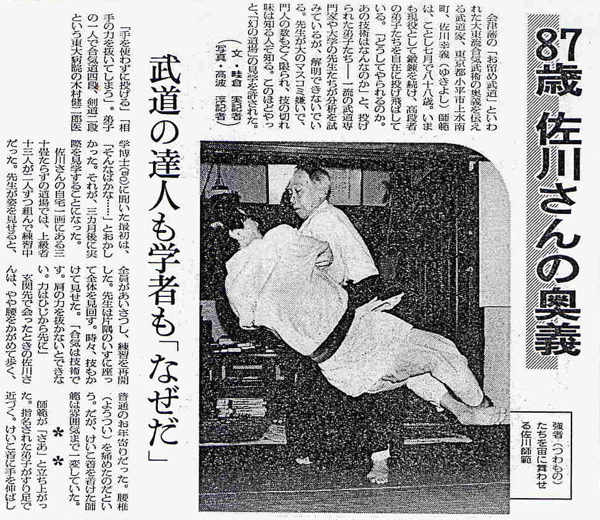
Article about Yukiyoshi Sagawa in the Asahi Shimbun, January 8th 1990
May 26th, 1966
You can’t think of your opponent other than in terms of applying technique. If their bones break or whatever it’s okay. If you don’t do that then you will be the one that it is done to. If you can’t do that than it’s better to give up Bujutsu.
If you stand up then you must not shrink away. It’s normal for any human being to stand up when faced with a real fight. However, if resign yourself completely to face whatever may happen then you will be able to move quickly.
December 8th, 1966
Treat training as if it is a real fight, treat a real fight as if it is training.
September 22nd, 1967
Regarding the saying “Society says that Sumo is three-tenths technique and seven-tenths Ki-Ryoku”. Talking about technique as three-tenths and Ki-Ryoku as seven-tenths, as technique and Ki-Ryoku in opposition, it’s not good. A person with Ki-Ryoku researches just as much technique. Both sides are in complete harmony. You cannot step away from a fight in the middle. You have to stick with it where ever it goes.
October 25th, 1967
Even when Takeda sensei turned eighty he never lost to younger opponents. Even in the bath, if he thought that somebody splashed him he’d immediately start to fight. When I was with him I would always stay close and keep an eye on him, but when he went alone to the public bath (“sentou” / 銭湯) in Osaka there was a time that he flipped eight young people on their backs and stuffed them in the bathtub.
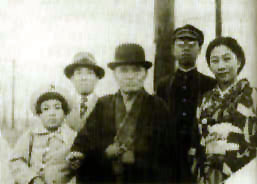
Sokaku Takeda (note the derby) and family
May 29th, 1968
As I remember Takeda sensei, he would always wear a derby, and he’d wear the diamond shaped Takeda mon every day. The cord on his haori was thick and purple and his magnolia wood geta had white leather straps. He always wore socks.
When he met someone for the first time he’d glare at them and look them over with a scowl from bottom to top, so everybody would be frightened. If he wasn’t allowed to sit above the priest at memorial services he would start saying nasty things like “Those priests smell like fish…” (Translator’s note: meaning the priests were corrupt) and in the end Sensei would end up sitting by himself in the high seat (he really made some very clever and cutting remarks). However, when I saw someone who was a student of a Naval Admiral sitting in hanmi in the lower seat I thought that Takeda really was a person able to wield tremendous authority.
His forearms and hands were extremely large, his forearms were about as large as mine are now (27.8 cm around the wrist), and his little finger was about the same size as my index finger.
May 14th, 1971
In Bujutsu it is necessary to intimidate your opponent. Both in training and in everyday life Takeda sensei would always glower at the other person, and it felt as if something with a blood thirst was prowling in the area. I guess that a person who can create an atmosphere like that is a real master. His students were so intimidated that none of them even thought about resisting. I also never accommodated myself to another person’s practice. Everyone trained just trained for their own progression.
May 12th, 1971
Mental strength is extremely important. Since you don’t know the real abilities of someone that you’re facing for the first time, no matter how weak they look you must treat them seriously. In my case, no matter what kind of a person I am facing I always apply the technique seriously.
No matter what kind of a person he was facing, Sokaku Takeda sensei would always use all of his strength, and that’s the way that I learned. You cannot apply a technique if you think of getting into an exchange with an opponent, it’s necessary to be resolved to press them down to the very end.
May 12th, 1971
If you don’t confront them seriously you will not be able to adapt to the attack of the enemy in an instant. You are not applying the technique with enough intent to break the arm, so if they struggle it will not be effective.
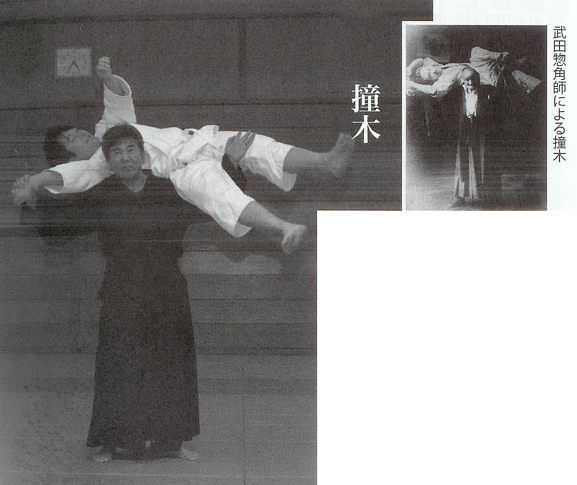
Sagawa student Youichi Shiosaka demonstrating “Shumoku”
(撞木 / “wooden bell hammer”)
Yukiyoshi Sagawa commented on this picture of Takeda in part 1
August 6th, 1971
Anyway, Takeda sensei would sit and glare at the person across from him, so faint-hearted people would be too afraid even to speak. I knew him from when I was a child, so I thought that was normal and didn’t think anything of it. There was a blood thirst pervading the air around Takeda sensei.
April 9th, 1973
Age-te
Bujutsu is not like something you just shape out of clay, the “Rising” (“Ageru” / 上げる) Ki-Ryoku must be present. However, if we’re getting to technique then it’s a different matter.
January 8th, 1967
In your first real fight you tend to stand up too high, so it’s better if you keep your body low when you use your strength.
January 9th, 1970
It’s necessary to be fast, but if you become stiff then your effective power drops down to about a third. In a real fight, especially if you are holding a sword, step forward using the techniques that you have learned up until now with just the intention of practicing how to step forward and cut. It’s necessary to step forward with Mushin (無心). If you think that you have to win, somehow when you think about winning you become stiff and it leads to defeat.
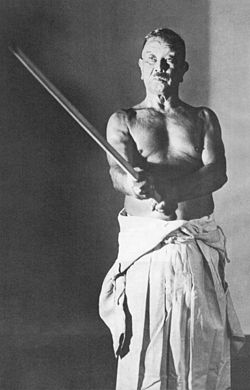
Sasaburō Takano (高野佐三郎 / 1862 – 1950) of Nakanishi-ha Itto-ryu
one of the fathers of modern Kendo
October 21st, 1974
Tokimune Takeda sensei came to visit with his student, Mr. Katsuyuki Kondo. Yoshimaru was present, and created this account.
[Object of the Visit]
In order to entrust the title of Daito-ryu Aiki Budo, So-Hombu, So Hombu cho (大東流合気武道総本部総本部長 / “Daito-ryu Aiki Budo, General Headquarters, Director of the General Headquarters”). In accordance with the previous agreement, the office of So Hombu cho was vacant, and it would be permissible (for Yukiyoshi Sagawa) to take the titles of So Hombu cho and Sohan (宗範). Sensei refused.
[Said by Yukiyoshi Sagawa sensei]
Kendo gathered the essence from the various Koryu, and there was a serious question as to whether the truly best things would be hidden, but when the forms were decided each teacher hid a knife in their clothing and attended the conference. My personal opinion is that perhaps Daito-ryu could also be best transmitted correctly to future generations in this manner. I also think that it is desirable for the individual instructors to be allowed to continue their independent research.
[Said by Tokimune Takeda sensei]
The Urawa Police was in Sasaburo Takano’s (高野佐三郎) territory, and everybody was very confident. When we went to teach there I was told “You go first!”, so I went first by myself. That was when I was around twenty years old. I put on a stand up collar because my face was childish, I didn’t look more than sixteen. They told me that I was an idiot, useless, and they bragged about their martial prowess. After that I applied a Yonkajo and when I raised it up they were so shocked that they fell flat to the ground and apologized. The next day Sasaburo sensei came and instructed.
At that time Sokaku sensei took a large man who was a sixth dan in Judo, grabbed him in a Sankajo, and said “Okay, move!” as he walked him around the Dojo. Sensei, who was so tiny, really looked huge at that time. Sagawa sensei and I both said that it was really mysterious.
After that Sagawa sensei also reminisced about how Sensei had appeared so large at the time.
January 10th, 1971
“Shiai” (“contest:” / 仕合) is “death” (“shi” / 死) and “meet” (“ai” / 合い). In a fight, if you just think about things like not getting injured you can’t really fight. You have to fight as if you are intending to die.
October 13th, 1971
First, apply Aiki. If you take a stance like “Come and get me!”, then however they come you will be able to apply Aiki immediately.
Christopher Li – Honolulu, HI

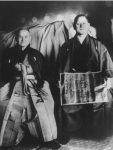
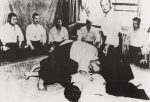
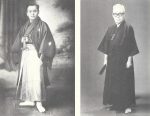
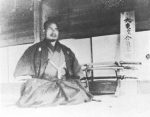
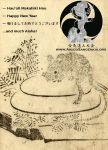
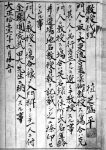
Leave a Reply